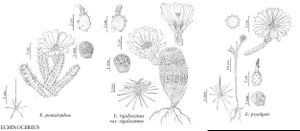Difference between revisions of "Echinocereus pentalophus"
Cact.-Verz., 20. 1859.
FNA>Volume Importer |
FNA>Volume Importer |
(No difference)
| |
Revision as of 22:22, 16 December 2019
Plants branched, clumps to 20 × 100 cm. Stems weak, sprawling, soon decumbent [erect and rhizomatous], ± 10–60 × 1–2[–6] cm; ribs 4–5, crests sharp and straight to poorly defined and undulate; areoles 5–12 mm apart. Spines (3–)4–7(–9) per areole, usually very stiff and straight, yellowish, tan, ashy white to dark gray, or pale pink, tips dark, all terete; radial spines (3–)4–6(–8) per areole, spreading, 6–37 mm; central spines 0–1 per areole, porrect or ascending, 4–36(–60) mm. Flowers 6–10 × 7.5–10(–15) cm; flower tube 20–25 × 8–20 mm; flower tube hairs 3–6 mm; inner tepals brilliant pink or magenta distally with distinct white or yellow proximal regions of variable extent [very rarely white throughout], 3.5–6 × 9–18 mm, tips relatively thin and delicate; anthers orange-yellow; nectar chamber 3–6 mm. Fruits green, (10–)15–25 mm, pulp white. 2n = 22.
Phenology: Flowering Apr–May; fruiting 3-4 months after flowering.
Habitat: Tamaulipan thorn scrub, Agave lechuguilla-Hechtia associations, alluvial coastal plains, [pine-oak forests, limestone cliffs]
Elevation: 0-2200 m
Distribution

Tex., Mexico (Coahuila, Nuevo León, San Luis Potosí, Tamaulipas).
Discussion
Our northern plants of Echinocereus pentalophus are var. procumbens (Engelmann) P. Fournier; they have often been misidentified as E. berlandieri. Both taxa have often been misidentified as the Mexican species E. blanckii [often misspelled as E. “blankii”], of confused authorship. Confusing variation of E. pentalophus has promulgated misidentifications, misapplications of names, and attempts to recognize multiple taxa.
Selected References
None.
